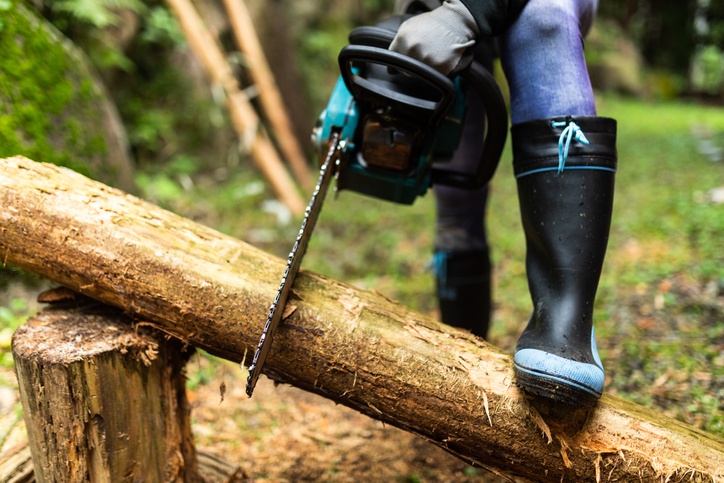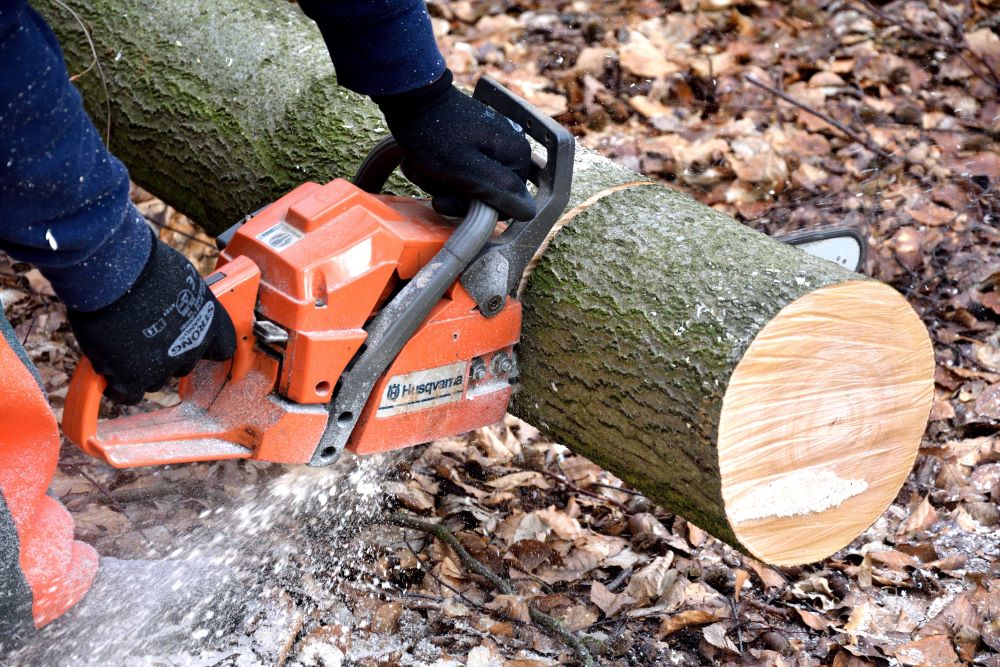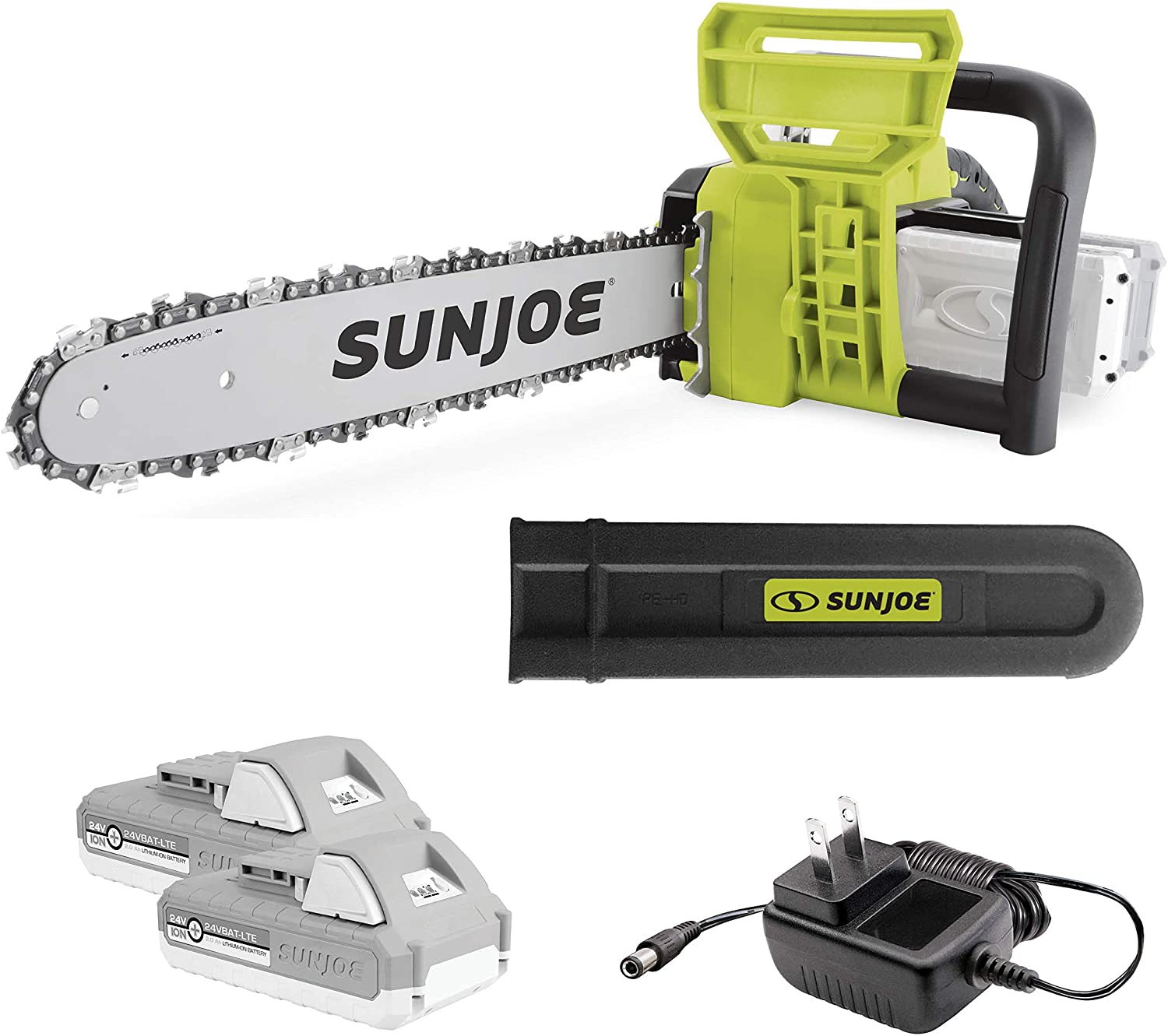Chainsaws are vital for tackling tasks like logging, pruning, and timber production. However, they can be overwhelming for first-time users. After all, many chainsaw models are heavy, hard to control, and capable of causing fatalities when not used properly.
That’s why we’ve written this comprehensive chainsaw guide for beginners. Read on to learn chainsaw anatomy, chainsaw basics, typical uses for a chainsaw, and types of chainsaws. We’ll also share tips for beginner chainsaw users.
What Makes Up a Typical Chainsaw?
Before diving into our Chainsaw 101, let’s look at the parts of a typical chainsaw.
Guide Bars
The guide bar is the metal bar around which the chain spins. It keeps the chain straight while cutting. There are two types of guide bars:
Laminated Guide Bars
Laminated guide bars are made by fusing two steel rails with a sprocket and a steel core. This makes them lighter and more flexible than solid guide bars. They also tend to be more affordable. On the flip side, laminated safety guide bars also get damaged more easily.
Laminated guide bars can be identified by the spot weld marks on the sides. You can get them from all major manufacturers, including Oregon, Sugihara, Stihl, Husqvarna, and Tsumura.
Solid Guide Bars
Solid guide bars are much more durable than laminated guide bars are because they’re made from a single piece of steel. They’re also easy to straighten by bending them back into shape.
Solid guide bars can be identified by the lack of spot weld marks. Like laminated guide bars, solid guide bars are available from all major manufacturers.
Chain Brake
One of the most important chainsaw safety features is the chain brake, which stops the chain from moving in the event of kickback. Kickback is when the guide bar unexpectedly thrusts upward toward you. It usually happens when the chain gets pinched or the chain tip gets nicked.
There are two types of chain brakes:
- Inertia-activated chain brakes, which automatically activate based on chain rotation force
- Manual chain brakes, which are handguards that get pressed during kickback
Chain Catcher
Another vital chainsaw safety device, the chain catcher is a guard that catches the chain if it breaks while spinning. This feature can protect you from getting hurt by a snapped chain.
Throttle and Safety Throttle
In electric and battery chainsaws, the throttle controls the amount of amperage or electric power in the motor. In gas chainsaws, it controls the amount of fuel that reaches the combustion cylinders.
As for the safety throttle, it’s a switch that prevents you from accidentally activating the throttle. You must press the safety throttle before you can activate the throttle.
Starter Handle
Gas chainsaws typically require you to pull a starter cord to kickstart the engine. A starter handle is an ergonomic handle that makes it easier to pull the cord.
Engine
Chainsaw engines are either:
- Two-stroke or two-cycle gasoline internal combustion engines
- Electric motors powered by an electric power cord or battery
Gas chainsaw engines use the former, while electric and battery-powered chainsaws use the latter.
Tensioning Mechanism
Also known as the chain tensioner, the tensioning mechanism maintains proper tension on the chain so the tool cuts safely and smoothly. If the chain is too loose, it can easily fall off while you’re working. If it’s too tight, the blade may not spin after the throttle is engaged, which can cause damage to the saw.
Typical Uses for a Chainsaw
Professionals and Do-It-Yourself (DIY) enthusiasts can use chainsaws for many applications, including:
Cutting Down Trees
Chainsaws are ideal for cutting and chopping wood. With the proper safety precautions, the right amount of power, and an appropriately-sized chainsaw, you can easily take down trees of various sizes.
Splitting Firewood

Say goodbye to your axe. A powerful gas, electric, or battery chainsaw will help you split firewood faster than ever before.
Bucking
You can also use your chainsaw for bucking — cutting a fallen tree into smaller products like logs, pulpwood, studwood, and fence posts.
Power Sources for a Chainsaw
Chainsaws can have three power sources: electricity, gasoline, and batteries.
Electric Chainsaws
Also known as a corded electric chainsaws, an electric chainsaw runs on electricity. To start cutting, just plug it into a power source. It will run as long as you have access to electricity.
Corded Electric Chainsaw: How It Works and Which To Choose
Advantages of Using Electric Saws
Electric chainsaws offer many advantages, including:
Easy to Carry Around
Electric chainsaws are incredibly lightweight. Unlike gas and battery-powered saws, they have few moving parts and no batteries.
Less Noisy
Electric chainsaws are significantly quieter than their gas-powered equivalents are. They have an average sound range of 90–102 decibels, which is 10–20 decibels lower than the average gas chainsaw is. Every eight decibels stands for a doubling of sound, which means that electric chainsaws are two to three times quieter than gas saws are.
Easy to Maintain
Unlike their gas-powered counterparts, electric saws don’t require you to store gasoline. You also don’t have to worry about the gasoline degrading over time.
No Need to Refuel or Recharge
Electric chainsaws don’t require charging or refueling. You can use them as long as they’re plugged in. Accordingly, they’re the best choice for projects that last the whole day.
- 12A motor rotates the chain at up to 44 feet per second
- Lightweight design limits fatigue to the user
- Auto-oiling system lubricates itself to elongate the saw’s lifespan
- Tool-free chain changes make for easy and fast chain replacement
- Requires no gasoline for emission-free operation
Disadvantages of Using Electric Saws
However, as with all tools, electric saws have some drawbacks.
Not as Powerful as Gas-Powered Chainsaws
Corded electric saws are usually less powerful than their gas-powered cousins are. Most electric saws can only cut down small and medium-sized trees.
Less Portable
Unfortunately, corded electric saws are the least portable type of chainsaw. Unlike gas and electric-powered saws, corded electric saws must be plugged in at all times. Your flexibility is determined by the length of your extension cord.
Gas-Powered Chainsaw
First developed in the 1920s, gas-powered chainsaws run on gasoline, making them more powerful than their electric-powered cousins are. They remain the go-to choice for logging and other heavy-duty tasks.
How Does a Gas Powered Chainsaw Work?
Advantages of Using Gas-Powered Saws
Gas-powered chainsaws enjoy immense popularity for many reasons, including:
More Powerful Motors Than Other Types of Saws
Gas chainsaws are known for their powerful motors. Most gas-powered chainsaws have two-stroke or two-cycle engines that run on a mix of fuel and engine oil, which means the engine only needs two piston strokes to generate power. As such, these saws can fell large trees. Some models can even saw through concrete and steel.
Great For All Types of Projects
Gas-powered saws aren’t only for logging. You can also use them for:
- Tree bucking and pruning
- Harvesting firewood
- Gardening and landscaping
- DIY projects
- Assembling furniture
- Cutting firebreaks in wildland fire suppression
- Cutting ice for winter swimming and ice sculpture
- Cutting concrete and steel during construction projects
Longer Lifespan Than Electric and Battery-Powered Saws
Gas chainsaws also have longer lifespans than their electric and battery-powered cousins. If you take proper care of your gas chainsaw, it can last 10 to 20 years.
Electric and battery-powered chainsaws are generally less durable because they store energy on lithium-ion batteries. While these batteries can be recharged, they will degrade over time.
- Powerful Engine: 2-cycle 58 cc engine provides more power, perfect for cutting jobs around garden or far
- Durable Chainsaw: The chainsaw will make tasks like tree pruning, clearing land, preparing firewood or cleaning up after a storm easier
- Anti-Vibration System: It reduces vibration levels, for more comfortable use of chainsaw
- High Safety: The quick stop chain brake helps to use more securely; The chain saw is provided with a safety switch to protect against accidental starts to ensure the safety of the user
- Easy Start: Equipped with a designed engine and starter for easy and fast starting with minimum effort
Disadvantages of Using Gas-Powered Saws
Although gas-powered saws offer many benefits, they also have a number of disadvantages, including:
Noisy
Gas saws are the loudest saw type.
Depending on the size, brand, and model, gas chainsaws can produce sounds of 106–120 decibels. This isn’t just a minor inconvenience — noises this loud can cause significant health problems. According to the Centers for Disease Control and Prevention (CDC), noises up to 106 decibels can cause hearing loss in less than five minutes, while noises up to 120 decibels can cause pain and ear injury.
It’s imperative to wear hearing protectors when using these saws. Taking regular breaks will also protect your ears.
Requires Storing Gasoline

Gas-powered saws require you to store gasoline.
Depending on where you live, this can be a difficult or impossible task. According to the Consumer Product Safety Commission, gasoline storage is especially dangerous for apartment dwellers. Keeping gasoline in the car or house is also ill-advised since houses and cars have multiple ignition sources. The best way to store gasoline is to keep it outdoors and far away from living quarters.
You also need to keep a close eye on your gasoline supplies. Regular gasoline only has a shelf life of three to six months, so you have to properly store, label, and replenish your gas. Otherwise, you’ll run the risk of using old gas, which may damage your saw’s internal components.
Requires Mixing Oil and Gasoline
If you have a gas chainsaw, you need to mix oil and gasoline to keep things running smoothly. This requires a lot of time and specialized knowledge. If you don’t have the right gas-to-oil ratio, the chainsaw won’t run properly. You may also damage the engine.
Requires More Maintenance
Owning a gas chainsaw can suck up a lot of time and energy.
For one, you have to clean the fuel tank on a regular basis. If you don’t, old debris and contaminants in the tank may damage the engine. You also have to clean your saw’s fuel filter.
More Expensive
Gas-powered saws are also more expensive than other saw types are. Price points vary depending on the brand and model, with the average gas saw costing over $500. In contrast, the average cordless and corded saw costs $200 and $150, respectively.
Heavier
If you’re looking for a lightweight saw, gas-powered saws aren’t your best bet. The average gas chainsaw weighs 12 to 16 pounds. Meanwhile, corded electric and cordless battery saws weigh six to 12 pounds and 10 to 12 pounds, respectively.
Battery-Powered Chainsaw
Also known as cordless battery chainsaws, battery-powered chainsaws run on batteries instead of electricity and gas. Many homeowners have shifted to battery-powered chainsaws because they are more eco-friendly, less noisy, more budget-friendly, more portable, and easier to maintain than other chainsaws are.
Historically, cordless battery chainsaws were less powerful than other chainsaws were. Thanks to advances in battery technology, however, many modern chainsaws can handle logging and other heavy tasks.
How Does a Battery-Powered Chainsaw Work?
Advantages of Using Battery-Powered Saws
Battery-powered chainsaws provide multiple advantages, including maximum portability and improved safety. Here’s a rundown of their best features:
Maximum Portability
Cordless battery-powered saws don’t need to be plugged in, so you can use them whenever you’d like. They’re particularly good for projects in tight corners and other hard-to-reach areas.
Quieter
Battery-powered chainsaws are equally as quiet as their corded electric cousins are. This means that they’re two to three times quieter than gas saws are.
Improved Safety
Cordless battery-powered saws offer maximum comfort and convenience. Since they don’t have to be plugged in, you can use them wherever you’d like. Cordless battery saws also make the workplace safer by:
- Reducing or eliminating tripping hazards caused by cords
- Giving you more leg and arm room to work on tasks, especially those that require a lot of twisting and turning
- Giving you more space to store and use equipment
Additionally, battery-powered saws have several features that make them safer for homeowners and other casual users. These include:
- Shorter bars that make the saw easier to control
- Lower chain speeds
- Chains that only run when you’re actively using the saw
Easy To Use
Battery-powered chainsaws are much easier to set up than other saw types are. They don’t require you to find a power source or mix fuel — just pop in a battery, turn on your saw, and start cutting right away.
They also have fewer parts to maintain. Unlike gas saws, there are no fuel tanks to clean, no fuel filters to change, and no oil and fuel to mix before cutting. All you have to do is keep the bar oil filled and the chain tensioned and sharp.
Cleaner Energy Than a Gas Chainsaw
Finally, battery-powered chainsaws are more eco-friendly than gas chainsaws. Because they run on batteries, they don’t use fossil fuels or emit carbon emissions.
- 【Gas-Like Power for Professional Cutting】Powered by dual 20V batteries, this 40V cordless chainsaw delivers gas-like cutting performance, making it perfect for professional arborists, loggers, and experienced DIYers. Tackle demanding tasks like tree felling, firewood cutting, and storm cleanup with ease.
- 【Heavy-Duty Performance – Up to 150 Cuts Per Charge】Equipped with a high-efficiency brushless motor, this chainsaw delivers consistent power and durability, effortlessly handling up to 150 cuts on 4x4 wood per charge. Ideal for tough cutting jobs without the hassle of gas maintenance.
- 【Tool-Free Chain Tensioning – Quick & Hassle-Free】Adjust your chain on the go without tools, ensuring smooth operation and less downtime. Whether you're a homeowner or a pro, this user-friendly feature keeps your chainsaw in peak condition with minimal effort.
- 【Instant-Stop Chain Brake for Maximum Safety】Designed for safe operation, the instant-stop chain brake prevents accidental cuts and enhances user protection. Perfect for job site professionals and home users looking for secure and reliable performance.
- 【Versatile Battery System – Power More Tools】Part of the DongCheng 20V and 40V tool lineup, this chainsaw works with interchangeable batteries, allowing you to power multiple tools with the same battery system, maximizing efficiency and cost savings.
Disadvantages of Using Battery-Powered Saws
Unfortunately, battery-powered saws also have some disadvantages. These include:
Less Powerful Than Gasoline-Powered Saws
Battery saws are much more powerful than they were 10 or 20 years ago. However, gas-powered saws are still the industry standard for construction and outdoor work. In other words, you should get a gas-powered saw if you want to cut large trees effectively and efficiently.
Shorter Running Time
Most battery packs only last two to three hours. This means you have to change batteries throughout the day. In comparison, corded electric saws can be used as long as they’re plugged into a power source.
Tips for Beginners
Now that you know how a chainsaw works and what you can use it for, here are some chainsaw tips for beginners.
Prevent Chainsaw Accidents by Reading the Instruction Manual
Before you turn on your chainsaw, look at your chainsaw’s instruction manual.
Also called the owner’s manual, the instruction manual has everything you need to know about your chainsaw’s anatomy and functionalities. It also contains recommended cutting techniques and protection gear, instructions for handling chainsaw chains, and safety precautions. Make sure you understand all of the instructions and warnings before using the tool.
Look Into Different Models of Chainsaws To Fit Your Needs
Choosing the right chainsaw is crucial. Otherwise, you’ll end up with a tool you can’t use.
The best chainsaw for beginners is a light-use electric or battery chainsaw. Light-use chainsaws are among the safest since their bars tend to be under 14 inches. They’re also lightweight and portable, making them easy to control. Many homeowners use them to prune trees and shrubs.
If you have some experience with chainsaws and you need a saw for cutting thicker logs and tree limbs, get a moderate-use chainsaw with a 16 to 18-inch bar. Most models are gas-powered, but some are electric or battery-powered.
If you’re a seasoned chainsaw user who needs to cut large trees, consider getting a heavy-duty chainsaw with a 20-inch long bar for large jobs. These beasts are specifically designed for cutting through large trees. Handle these tools with extreme caution — large chainsaws are much harder to control and are typically reserved for professional and commercial use.
Talk to an Experienced User for More Insight
You should also consider talking to an experienced chainsaw user for more insight. The right mentor can provide specific information and insights for mastering your chainsaw. For instance, they can show you how to:
- Efficiently chop wood
- Take proper safety precautions
- Mix oil and fuel for gas chainsaws
- Calculate your gas chainsaw’s fuel efficiency
- Store and take care of your chainsaw
- Lubricate your chainsaw
Ensure Periodic Maintenance
Finally, you need to take proper care of your chainsaw. Specifically, you need to:
Keep It Clean
The more you use your chainsaw, the more debris will get stuck on it. To continue working efficiently, you need to regularly clean each part of your saw.
Here are some tips for cleaning your chain, carburetor, and air filter:
- Chain: To clean the chain, take it off and soak it in water and ammonia for 30 minutes. Then, scrub the chain with a soft brush to remove the debris.
- Carburetor: Clean your gas saw’s carburetor by spraying fuel additive or compressed air into it. Then, remove the diaphragm, needle valves, and cover plate and place them into the water and ammonia mix you used for the chain.
- Air filter: Finally, clean the air filter with soapy water. Consider getting a new one if you can’t get the debris out.
Ensure Your Chainsaw Is Lubricated
Your chainsaw must be well-oiled to prevent friction between the chain and the guide bar. Without sufficient oil, the chain won’t spin as fast as it should, causing the saw to overheat.
The lubrication process varies depending on the model, brand, and manufacturer. Check your owner’s manual for instructions. Note that models with automatic oilers don’t require you to add oil manually.
- ECO-FRIENDLY LUBRICANT: With ultimate biodegradability, our green, non toxic chainsaw oil is made from North American grown plant oils, so it’s safer for you, safer for your pets and safer for the environment than petroleum based products.
- HIGH PERFORMANCE: Our professional Pro100 Bar & Chain Oil has a high flash point up to 600°F and excellent temperature stability even in extreme conditions. The all season bio-based commercial quality lubricant has a minus 20°F pour point.
- PROFESSIONAL QUALITY: Safer for your employees and better for your equipment, our yard-safe supreme grade chainsaw oil offers outstanding lubricity, superior wear protection, and is high tack to reduce high speed oil sling.
- NON TOXIC FORMULA: Containing no petroleum base oils or metal-based additives, our eco-friendly lubricant is ideal for chainsaws as they are 100% loss applications. This green lube is suitable for use around waterways and other sensitive areas.
- MADE IN THE USA DEWALT Bar & Chain Oil is USDA Certified Bio-based Product
Sharpen the Blades
A chainsaw will eventually become dull with use. Get a sharpener if you’re noticing the following:
- The saw is creating sawdust rather than wood chips
- You need to put more effort into cutting wood
- The blade is pulling to one side more than to the other
Follow these steps to sharpen your chainsaw blade:
- Set the file: Clamp the guide bar of the saw to your work surface. This will prevent the chainsaw from moving as you file it, resulting in an easier and more consistent sharpening process.
- Use the tension mechanism to tighten the chain: Locate the tension mechanism on your chainsaw and use a screwdriver to tighten the chain. The chain should be tight but still able to move around the saw with minimal effort.
- Mark the first tooth: Choose the first tooth you’ll be sharpening. Mark it with a permanent marker to avoid sharpening the same tooth or section twice. The mark will disappear when you start using the chainsaw.
- Get the right file: Pick a round file that has the same diameter as your saw’s teeth.
- Preparing to file: Put the file in the notch on the marked tooth so that a quarter of the file’s diameter is above the tooth. Then, check your owner’s manual and look for the correct angle for filing each cutter. Use a file holder to hold your file at this angle.
- File the tooth: File the marked tooth by sliding the file across the surface of the cutter. File the cutter three to 10 times until it’s shiny and appears sharp.
- Sharpen every second tooth from the marked tooth: Now that you’ve fully sharped your first tooth, rotate the chain to file another one. Chainsaw cutters face alternate directions, so you need to alternate between cutters on every other tooth. If you don’t alternate, you may throw off the chainsaw’s balance.
- This portable universal chainsaw sharpening kit by Oregon makes it easy to keep your chainsaws, pole saws, and other tools sharp and ready to go
- This versatile kit includes 1 x 5/32 Inch round saw chain file, 1 x 3/16 Inch round saw chain file, 1 x 7/32 Inch round saw chain file, 1 x 6 Inch flat file, 1 x file guide, 1 x universal file handle, and travel pouch
- With the handy file guide, you can ensure easy depth gauge setting and accurate, consistent results when sharpening your chains
- This field kit comes with a detailed instruction sheet, including a filing chart to help you align the right filing tool and technique to your chain
- This chainsaw blade sharpening kit comes in a compact rolled canvas pouch with inner pockets for each tool and a secure loop closure, perfect for taking from job to job
Learn and Understand Your Chainsaw Like the Back of Your Hand
Gas, electric, and battery-powered chainsaws are essential tools for homeowners and professionals alike. They’re great for various tasks, including logging, timber production, and bucking.
Reading the owner’s manual is the best way to learn and understand your chainsaw. You can also reach out to an experienced chainsaw user for more insight. A good mentor can help you master trimming and maintenance tasks like sharpening and lubricating in minimal time.








